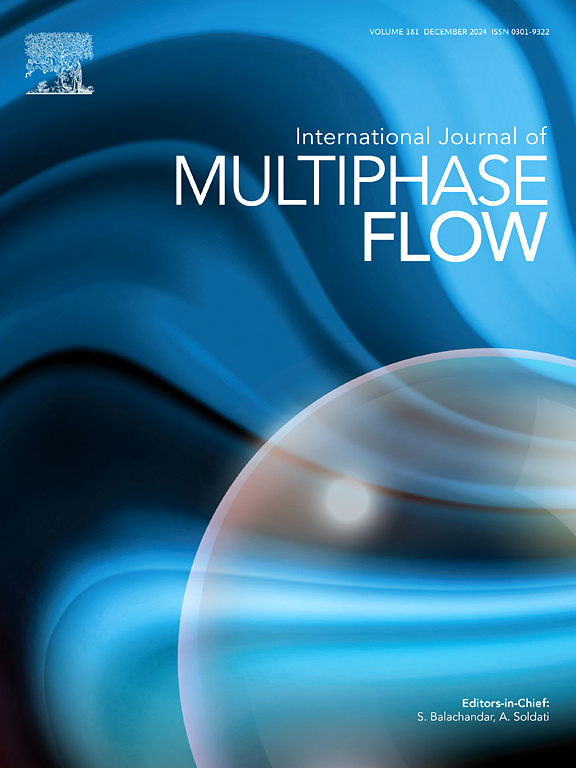Behavior of two-phase flow in a single pore with varying temperature and pressure
IF 3.6
2区 工程技术
Q1 MECHANICS
International Journal of Multiphase Flow
Pub Date : 2025-03-12
DOI:10.1016/j.ijmultiphaseflow.2025.105202
引用次数: 0
Abstract
For a saturated compositional fluid flowing through a porous medium, a gas phase can appear and disappear. This phenomenon is affected by flow rate, pressure, and temperature. By analyzing a 2 × 2 dynamical system, a previous study investigated the relationship between the aforementioned phenomenon and the injected flow rate at fixed temperature and pressure. The present research extends that study by exploring this phenomenon at various temperatures, initial bubble sizes and outlet pressures. Our results indicate that the direction fields of the 2 × 2 dynamical system depend on the outlet pressure and temperature. At certain critical temperatures, the direction field develops singularity points. These critical temperatures depend on the outlet pressure and the injected concentration of CO; the critical temperatures increase as the outlet pressure increases and the critical temperatures decrease as the injected concentration of CO increases. For a fixed outlet pressure and injection flow rate, whether the gas phase behavior is steady-state or cyclic (unstable spiral state) depends on the ratio between inlet and outlet channel radii, as well as temperature. Our computations demonstrate that, at a fixed temperature, the gas phase transitions from a steady state to an unstable spiral state as the ratio of the inlet and outlet channel radii decreases. The steady state features of bubble size, gas phase pressure and liquid pressure depend on the temperature; the bubble size increases while the gas and liquid pressure decrease as the temperature increases.

随温度和压力变化的单孔两相流动特性
对于流经多孔介质的饱和组分流体,气相可以出现也可以消失。该现象受流量、压力和温度的影响。前人通过分析一个2 × 2的动力系统,研究了在固定温度和压力下,上述现象与注入流量的关系。本研究通过探索不同温度、初始气泡大小和出口压力下的这一现象来扩展这一研究。结果表明,2 × 2动力系统的方向场与出口压力和温度有关。在一定的临界温度下,方向场出现奇异点。这些临界温度取决于出口压力和注入的二氧化碳浓度;临界温度随出口压力的增加而升高,随注入CO2浓度的增加而降低。对于固定的出口压力和注射流量,气相行为是稳态还是循环(不稳定的螺旋状态)取决于进口和出口通道半径的比值以及温度。我们的计算表明,在一定温度下,气相从稳定状态转变为不稳定的螺旋状态,入口和出口通道半径的比值减小。气泡大小、气相压力和液相压力的稳态特征取决于温度;随着温度的升高,气泡尺寸增大,气液压力减小。
本文章由计算机程序翻译,如有差异,请以英文原文为准。
求助全文
约1分钟内获得全文
求助全文
来源期刊
CiteScore
7.30
自引率
10.50%
发文量
244
审稿时长
4 months
期刊介绍:
The International Journal of Multiphase Flow publishes analytical, numerical and experimental articles of lasting interest. The scope of the journal includes all aspects of mass, momentum and energy exchange phenomena among different phases such as occur in disperse flows, gas–liquid and liquid–liquid flows, flows in porous media, boiling, granular flows and others.
The journal publishes full papers, brief communications and conference announcements.

 求助内容:
求助内容: 应助结果提醒方式:
应助结果提醒方式:


